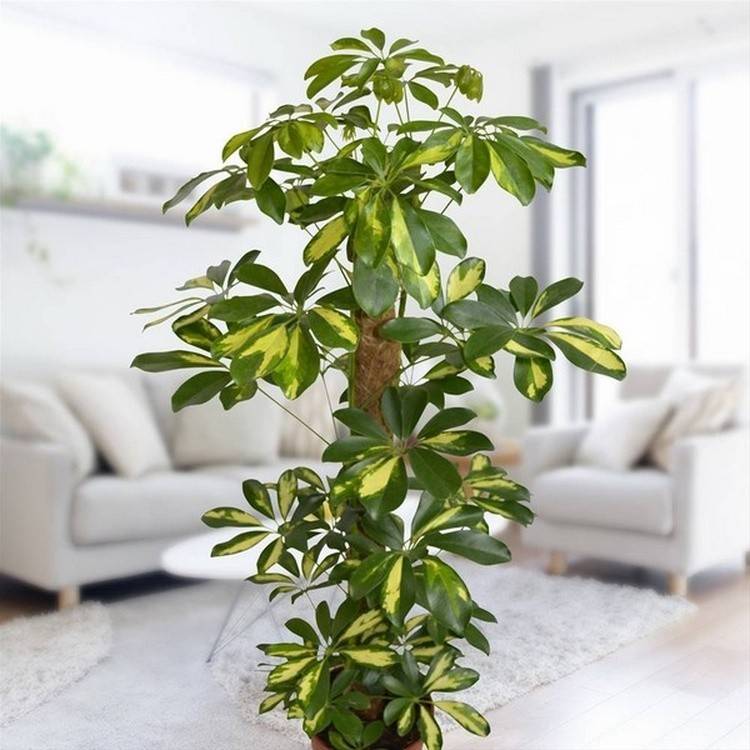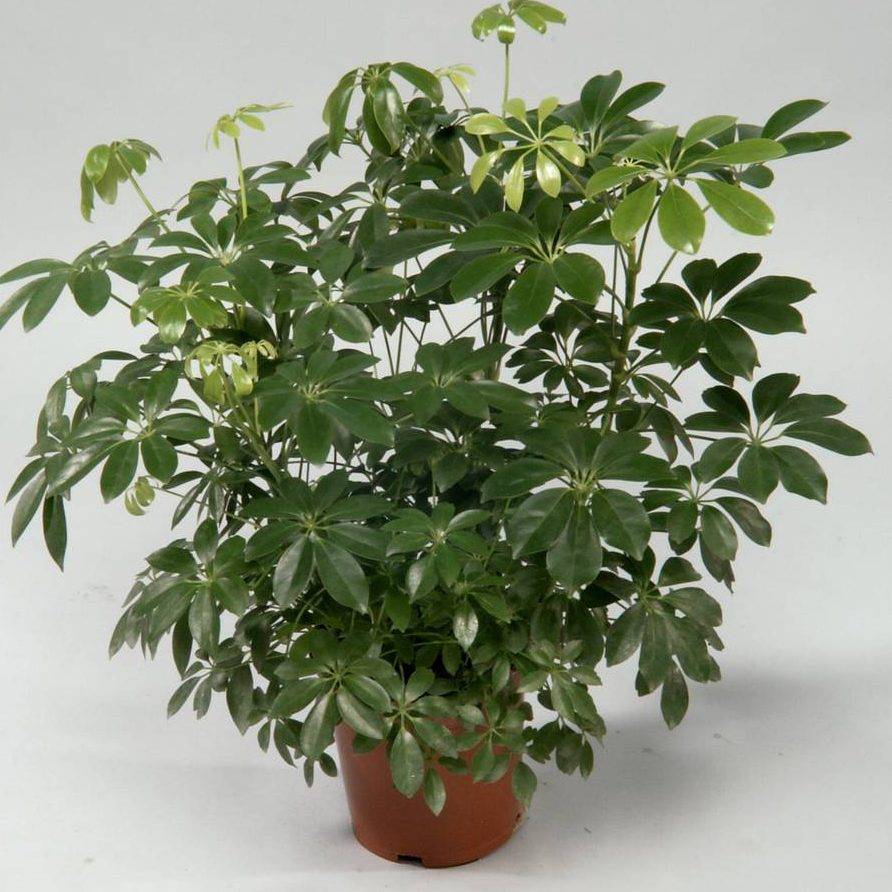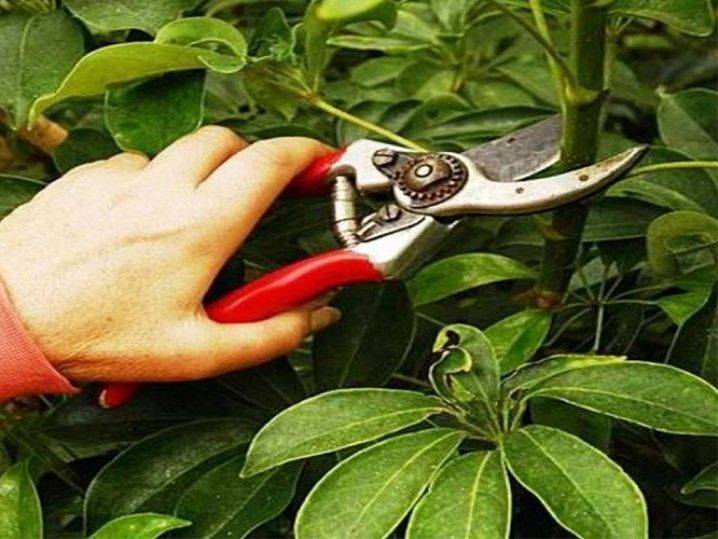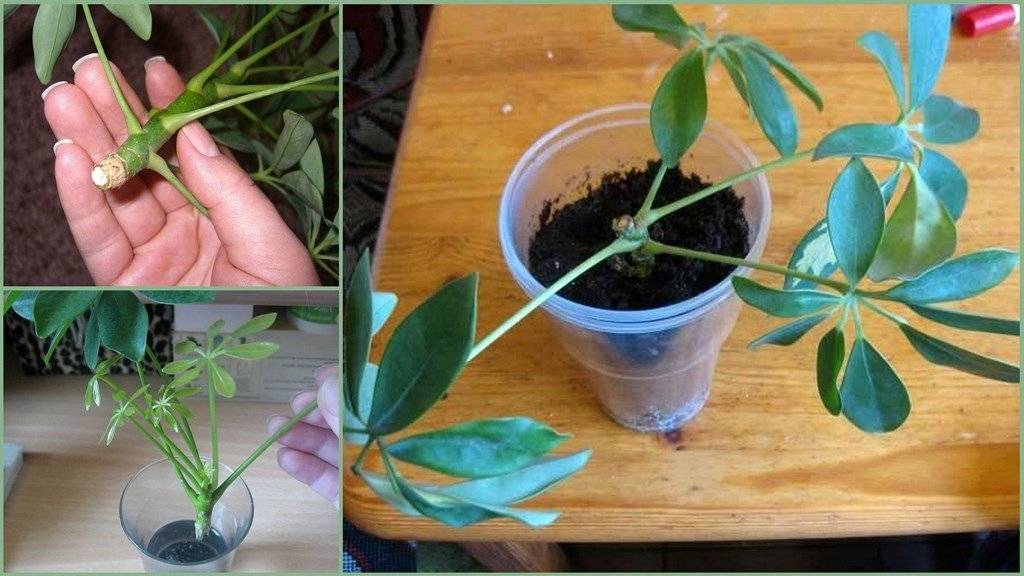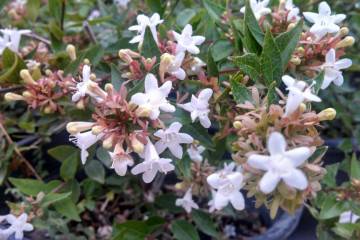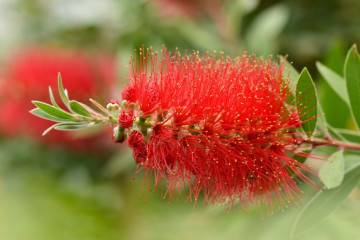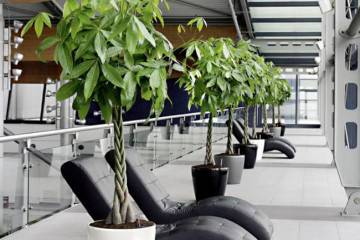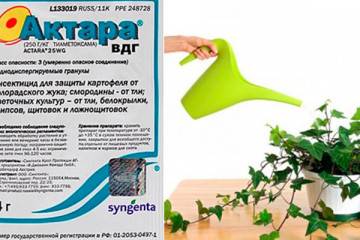Scheffler reproduction: interesting methods and examples of planting
Content:
Schefflera is an ornamental plant with beautiful carved leaves. In the wild, it is found in Australia, China and the Pacific Islands. It is used for landscaping apartments, offices and restaurants. Among the types of cheflers, variegated varieties are often found.
Home care
It is quite easy for a shefler to grow. She is unpretentious and undemanding to care for. Indoors, the following types of shefflers are mainly grown:
- eight-leafed;
- radiant;
- tree-like;
- palmate.
In order for the plant to delight the owners with its beauty, you should adhere to some rules of maintenance and care.
Lighting
Sheflera prefers sunlight. But even in partial shade, the flower feels good. An ideal place to grow a green beauty would be a well-lit indoor location.
The flower should be placed on a windowsill that faces east, west or north. If the windows face south, then the plant should be shaded in the summer. If this is not done, burns may appear on the leaves. Nordic windows are not suitable for variegated varieties, they need more light. In insufficient light, the pattern on the leaves will be less pronounced.
Moisture content
Sheflera prefers high humidity indoors. At the same time, it perfectly adapts to normal humidity.
In winter, if the temperature exceeds 19 degrees Celsius, and the air becomes dry, the flower begins to shed its foliage. Dry air affects the appearance of pests such as spider mites.
To make the chef happy with green foliage, it is necessary to spray it from a spray bottle twice a day, this will give the leaves an additional shine. It is recommended to wipe the leaves with a damp sponge once a week. It is desirable to place a decorative tree in places without drafts.
Temperature
For the cultivation and reproduction of chefs, a temperature of 15 to 20 degrees above zero is suitable. The plant does not like extreme heat.
High temperatures provoke yellowing and fall of foliage. In the warm season, the flowerpot can be taken out into the fresh air or placed on the balcony.
Watering
Sheflera prefers moderately moist soil. Strongly moistened soil can provoke rotting of the root system. Drying out the soil also harms the flower.
In summer, it is necessary to water the tree every three days. In winter - once every seven days. It is worth watering with settled, warm water. It is necessary to defend the water for at least a day.
Fertilizer
Schafflera prefers only fertile soils. During the period of active growth, the plant is fertilized once every ten days.
Top dressing is carried out in three stages:
- The first bait consists of nitrogen and phosphorus-potassium fertilizers, which are applied in early May. They contribute to the growth of green mass, and are also important for the proper development of the rhizome.
- The second groundbait is applied in a couple of weeks. Potassium and phosphorus are added to the soil.
- The third feeding is carried out in the fall. During this period, the laying of new leaves begins.Top dressing consists of superphosphate and potassium salts, as well as organic fertilizers.
Homemade solutions can be used for groundbait. As a fertilizer, you can use:
- Garlic water. Garlic is rich in vitamins, organic acids, sulfur and zinc. One clove of garlic should be squeezed out through a press and diluted in one liter of water. The mixture is left for 45 minutes. Then used as root bait.
- Banana peels. First, the peels should be dried, then finely chopped and soaked in water for a couple of days. Strain the solution and pour the liquid under the root.
Every two weeks, a liquid top dressing for indoor plants is applied.
Pruning features
Sheflera grows very quickly, so she needs regular pruning. If not done, the plant will grow to the ceiling. This procedure not only gives the plant shape, but also protects against pests.
There are two types of trimming:
- formation of crowns;
- removal of weak and yellow leaves.
For lush branching and a thick crown of the tree, it is necessary to cut off the top. Pruning is desirable in the spring, as soon as the plant wakes up after hibernation.
Cropping has several functions:
- Gives the flower the desired shape.
- It has a beneficial effect on the growth of new branches and leaves.
- Serves as a planting material.
- Removes weak and diseased branches.
Plant transplant
You need to replant a young plant annually. An adult chefler is transplanted every two years. A young bush is transplanted by transferring the plant from one pot to another.
A layer of drainage is poured into a new flowerpot at the bottom. Carefully place the plant there and cover it with nutritious soil. For transplanting, it is worth choosing a slightly acidic (pH not higher than 6), light soil. The procedure is completed by intensive watering.
When transplanting a mature plant, it is carefully removed from the pot. Then the root system is cleared of the earth. The roots are carefully examined for the presence of rot. At the end, the flower is planted in a new pot. It should be four centimeters larger than the previous one. A layer of expanded clay should be poured onto the bottom.
Reproduction methods
Often, beginners are worried about how to breed a chef at home. The flower is grown by seeds, air layers, cuttings.
Schefflera: propagation by cuttings
One of the simplest methods. But it is necessary to cut the stalk correctly. A branch with 4-5 rosettes of leaves is cut from an adult plant. Experienced growers advise cutting off cuttings in early spring. This will require a sharp knife or scalpel. Holding the tree by the trunk, the selected branch is carefully cut at an angle. The leaves are cut to half with scissors so that moisture evaporates less. You cannot break off a future sprout, it is worth cutting slowly.
How to propagate the chefler yourself? Cutting takes place in several stages:
- The top is cut off from the bush, placed in a container with water.
- After 12 days, roots appear on the plant.
- After the emergence of the root system, the cutting can be divided and transplanted as a separate plant.
- Before planting, the flowerpot should be disinfected with a weak solution of manganese permanganate and dried.
- A drainage layer is poured onto the bottom of the container.
- The soil is poured up to half the height of the flowerpot, so that the root does not go beyond the edge of the pot. Ideally, the edge should not reach 1.5-2 cm.
- The stalk is placed in the middle and covered with soil. The upper shoots will be open until the first shoots appear.
- At the end, the soil is moistened.
In a similar way, you can propagate the chefler with a leaf. The probability of successful rooting is lower than with a cuttings.
How to propagate by seeds
The seed method is quite laborious. This method is preferable in cases where it is not possible to get the stalk. Seeds should be purchased only in flower shops. Even if the seeds are of high quality, there is no guarantee that seedlings will turn out from them.
Seeds are usually sown in February. By the summer, the first shoots will grow up and begin to develop actively in comfortable conditions.
Step-by-step instruction:
- The seeds should be soaked for 24 hours.
- Sow the seed in a wide container, two-thirds full of soil.
- Spread the seeds into shallow holes, sprinkle with soil on top.
- Cover the container with seedlings with foil.
- Ventilate and moisturize once a day.
- After the appearance of the first leaves, the shoots must be planted in separate containers.
For the first three months, it is necessary to maintain the air temperature within 18-20 ° C. It is possible to propagate the chefler by seeds if the instructions are followed.
Air diverters
Growing a flower by layering is a very entertaining method that is used not only for indoor plants, but also for horticultural crops.
How to root a chefler using air layers? On the trunk, you need to clean up a small area up to 5-7 centimeters high. In a container, knead the activated carbon. Apply a thin layer to the cleaned area.
Wrap the treated trunk with foil, tie a branch with a rope at the bottom, forming a small barrel. From above, the trunk is loosely tied, leaving a small hole.
Then the shoot is attached to a stick, which is placed in a pot to a flower. Water the plant through the top hole. After 21 days, the first roots appear on the future bush. The film is carefully removed. The sprout must be cut at an angle and planted in a new location.
Possible problems
When growing chefs, gardeners can face some challenges. Often, with improper cultivation and care, the flower is attacked by pests:
- Spider mite. The plant is covered with a thin web. White-yellow blotches are visible on the leaf. To destroy the pest, the leaves are washed with soapy water, and then Actellik and Fitoverm preparations are used.
- Greenhouse aphids. The insect is dangerous because it sucks the juice from the plant. The leaves turn orange, then curl and fall off. Against aphids, drugs Actellik and Fufanon are used.
As a preventive measure, you can wipe the leaves with soapy water and give the flower a warm shower.
With improper planting and care, the flower may face the following problems:
- Powdery mildew. The deciduous blade is covered with a white, powder-like coating. If you look closely, you can see small ulcers from which fluid is released. The leaves begin to wither, dry and fall off. You can get rid of powdery mildew using systemic fungicides.
- Rust. This disease affects the stems and leaves. A symptom of the disease is clusters of orange or brown spores on the underside of the plate, yellow oval or round spots on the top. Then the spots turn into brown streaks and the leaves fall off. Eliminate the disease with chemicals: Topaz, Abiga-Peak, Baktofit.
- Gray rot. The main reason for the appearance is the location of the flower in a cold, damp room. The disease can be detected by a gray bloom on the sheet. Infected leaves are removed and the plant itself is treated with chemicals such as Fundazol.
- Bacterial spotting.Watery glassy spots appear on the back of the leaves, which eventually turn dark brown. It is impossible to cure the plant, it should be disposed of along with the soil, and the pot should be disinfected.
Falling foliage
It so happens that the leaves turn yellow, the plant begins to massively shed its foliage. Why do chefs have leaves falling? This is often associated with dry indoor air.
If a problem is found, it is necessary to check the soil in the pot, it must be wet. Drying out of the soil slows down the growth of the deciduous blade, it weakens and falls off. The fall of variegated foliage can be caused by a lack of light. Too wet soil can also trigger leaf shedding.
Blackening of the leaves
When the root decays, the leaves of the flower begin to turn black. This happens when you water it too often.
The flower is taken out of the pot and the damaged roots are carefully removed. After they must be sprinkled with crushed coal, dried.
Adhering to the rules of care and planting, you can easily grow a chef at home. It is believed that even a novice lover of indoor flowers can cope with this.
